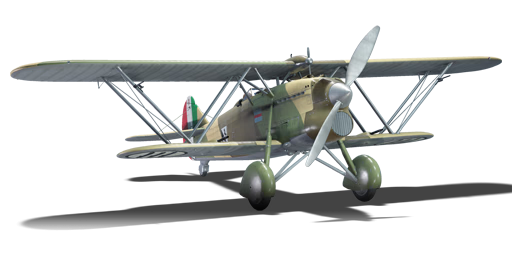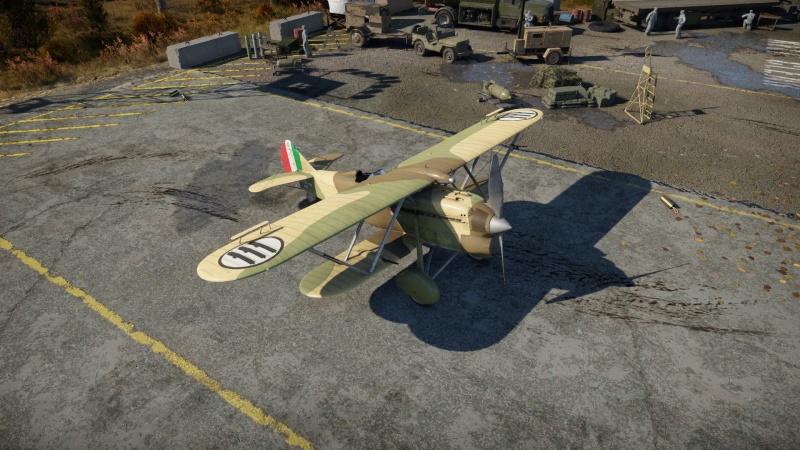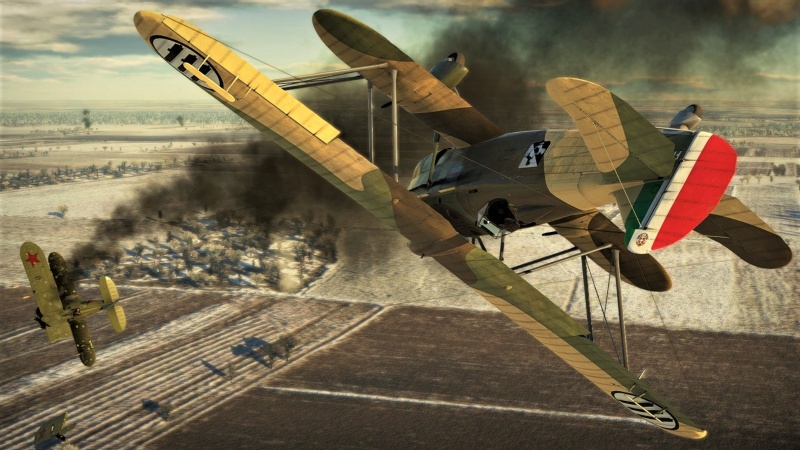CR.32 bis
| This page is about the Italian fighter CR.32 bis. For other versions, see CR.32 (Family). |
Contents
Description
After the development of the CR.32, an improvement of the aircraft was requested. In particular, two 7.7 mm machine guns were added, which increased the weight, though it was accepted by the pilots despite the loss of manoeuvrability and speed. 328 examples were produced from April 1936 until July 1937, and 45 of these were sold to Austria. These CR.32 were used in the Spanish Civil War with the Aviazione Legionaria with great success, proving to be deadlier than other biplanes also in service like the I-15, and even the I-16. They also served during World War II where they were later replaced with the more powerful CR.42 and relegated to training or used for civilian purposes.
Added with the introduction of the Italian aircraft tech tree as a premium pre-order pack for Update 1.69 "Regia Aeronautica", it was removed from the store after the 5th Anniversary sale but came back in the Warbonds shop as part of the first trophy chest in April 2018 until the end of Battle Pass: Season IV, "Fearless Voltigeur". The CR.32 bis is an improved version of the CR.32 and CR.32 quater. The main improvement is the firepower. The aircraft has a very similar flight performance to other biplanes, with very good turning speed, weak engines, very low energy retention and a low stall spead, they are also easier to fly in simulator battles, since they are usually more stable. The improved armament is a game changer, since it now has access to 12.7mm HMGs that are very lethal against other biplanes and also against early monoplanes like the Hurricane and I-16, although to a lesser extent. The most critical aspects of the CR.32 bis are the overall mediocre flight performance, the poor roll rate and the telescopic gunsight which is extremely hard to use in Simulator.
General info
Flight performance
Being essentially an upgunned reserve plane, the CR.32 bis' flight performance leaves much to be desired. While it can outturn most monoplane fighters, the CR.32 bis will occasionally struggle to dogfight against most of biplanes (especially the I-15 series). Its slow top speed and very poor energy retention also restricting its dogfight capabilities.
On the plus side, the CR.32 bis retain its great diving speed of its reserve counterparts, coupled with increased performance at higher speed, this makes it very excel at boom-and-zoom tactics, capable of strafing enemy from above before retreating.
| Characteristics | Max Speed (km/h at 3,100 m) |
Max altitude (metres) |
Turn time (seconds) |
Rate of climb (metres/second) |
Take-off run (metres) | |||
|---|---|---|---|---|---|---|---|---|
| AB | RB | AB | RB | AB | RB | |||
| Stock | 337 | 324 | 8500 | 14.9 | 15.5 | 4.9 | 4.9 | 150 |
| Upgraded | 365 | 356 | 13.6 | 14.0 | 14.9 | 9.2 | ||
Details
| Features | ||||
|---|---|---|---|---|
| Combat flaps | Take-off flaps | Landing flaps | Air brakes | Arrestor gear |
| X | X | X | X | X |
| Limits | ||||||
|---|---|---|---|---|---|---|
| Wings (km/h) | Gear (km/h) | Flaps (km/h) | Max Static G | |||
| Combat | Take-off | Landing | + | - | ||
| 590 | 590 | N/A | N/A | N/A | ~15 | ~7 |
| Optimal velocities (km/h) | |||
|---|---|---|---|
| Ailerons | Rudder | Elevators | Radiator |
| < 200 | < 300 | < 300 | > 190 |
| Compressor (RB/SB) | ||
|---|---|---|
| Setting 1 | ||
| Optimal altitude | 100% Engine power | WEP Engine power |
| 2,600 m | 591 hp | 788 hp |
Survivability and armour
- No armour plates or bulletproof glass
- Self-sealing fuel tanks located between engine and pilot
Modifications and economy
Armaments
Offensive armament
The CR.32 bis is armed with:
- 2 x 12.7 mm Breda-SAFAT machine guns, nose-mounted (350 rpg = 700 total)
- 2 x 7.7 mm Breda-SAFAT machine guns, wing-mounted (500 rpg = 1,000 total)
The main (and only) difference between the CR.32 bis and its reserve counterparts is the addition of two 7.7 mm Breda-SAFAT machine guns mounted on the wings. These guns provided extra firepower at close range, thought you might need to set convergence due to wing-mounted setup.
Usage in battles
The CR.32 bis is virtually similar to its reserve counterpart, the CR.32 with the exception of 2 additional 7.7 mm machine guns.Equipped with air targets belt, it can easily set other planes on fire. The only downsides of the plane are the lack of protection and speed. While these machine guns provided extra kick to the opponents, the CR.32 bis will have to face much faster and stronger opponents: monoplane fighers and bombers. The best way to use the CR.32 BIS is by playing as a support. As a biplane, you can easily outturn most opponents. The recommended tactic is to always have an altitude advantage over your enemies. Do not turn too much and fire your machine gun in bursts as you have limited ammo, this means you have to be more careful when engaging targets. With a top level speed of only 380 km/h, the CR.32 will be usually outrun by most opponents it faces. Instead, climb to much higher altitude, then use its surprisingly fast dive speed to execute boom-and-zoom attack to kill an unsuspecting opponents. While it can dogfight against monoplanes to some extent, the CR.32 bis' poor energy retention will eventually catch up and slow down the plane significantly, be decisive and strike at enemy weak points (engines, pilot, etc.) to finish them off as fast as possible.
Manual Engine Control
| MEC elements | ||||||
|---|---|---|---|---|---|---|
| Mixer | Pitch | Radiator | Supercharger | Turbocharger | ||
| Oil | Water | Type | ||||
| Controllable | Not controllable Not auto controlled |
Not controllable Not auto controlled |
Controllable Not auto controlled |
Combined | Not controllable 1 gear |
Not controllable |
Pros and cons
Pros:
- Good offensive capabilities
- 12.7 mm MGs are great for knocking out pilots and penetrating enemy armour plates
- 7.7 mm MGs provided extra firepower at close range and can be used to strafe soft targets
- Excellent dive speed
- Excellent high-speed performance
- Surprisingly good turning against monoplane fighters
- Fixed gear makes it easy to land
- Durable airframe for a biplane
- Effective self-sealing fuel tanks
- In Simulator it almost never spins, allowing some really tight manoeuvres to be performed without danger
Cons:
- Overall mediocre flight performance
- Sluggish top speed
- Turns worse than some biplanes it faces
- Poor roll rate for a biplane
- Terrible energy retention, will lose a lot of energy while turning
- Fixed gear increases drag
- No protection for the pilot
- Uses a telescopic gunsight which is extremely hard to use in Simulator
- Upper wing greatly obstructs the upward-forward view, a disadvantage in a Simulator dogfight
History
The CR.32 bis is virtually similar to what many people know as the CR.32, the only exception for this nimble aircraft is of 2 additional 7.7 mm machine guns. The FIAT CR.32 fighter biplane was developed by Celestino Rosatelli, an Italian aeronautic engineer who designed various planes such as the CR.32, CR.32 quater, CR.32 bis, CR.42, CR.42 CN, B.R.20DR, B.R.20M M1, and many more. After the development of the CR.30, Rosatelli modified it, changing the structure around the engine, the fuselage was the same as the CR.30 but without the supplementary tank, the armament constituted of 2 SAFAT 12.7 mm, and a transmitter, bomb thrower, or camera could be added. This plane was designated with serial number MM 201. Tested at Montecelio, the CR.30 (MM 201), later named CR.32, demonstrated as a perfect fighter and was the perfect conception of Italian fighter biplanes with a balance of manoeuvrability, performance, and military efficiency. In the mid thirties, the CR.32 was ordered by Regia Aeronautica, quickly replacing the CR.30, after which it was ordered by other nations. When the Second World War broke out, the CR.32 was already obsolete (and eventually replaced by the CR.42) but, in spite of that, it still equipped several fighter units. By 10 June 1940 the CR.32 was equipped for the following Gruppi Caccia (Fighters Groups): 24°Gruppo (52°Stormo) at Sarzana, 2°Gruppo at Grottaglie, 157°Gruppo (1°Stormo) at Trapani, 9°Gruppo at Monserrato, 160° at Tirana, 13°Gruppo (Partly) at Castelbenito (Libya), 8°Gruppo at Tobruk, 10°Gruppo at Benina and 163° Squadron at Rhodes. The first CR.32 to have been involved in military operations were those stationed in Libya, forty-odd machines being used mostly in ground attack missions together with the 50°Stormo's Breda 65s. The other front where the machine was used to the last example was Eastern Africa, fighting highly superior machines, such as Blenheims and Hurricanes. The old biplane closely followed the alternate phases of the campaign, from Italian advance into Egypt to the loss of Cyrenaica, they were widely used fairly successfully with various bomb types until January 1941. After the conquest of Crete in May 1941, CR.32s were relegated to fighting training duties. The CR.32 was used by Italy, China, Spain, Austria, Germany, Hungary, Venezuela and Paraguay. After the CR.32, other variants were created: CR.32 Bis, CR.32 ter, CR.32 Quater, CR.32 Quater CN, CR.32 Quater AS, CR.32 Serie 2. The CR.32 also had amazing characteristics which allowed the aircraft to be used by Aerobatic Teams from 1936 to 1939 in various aeronautic events.The 4°Stormo was first in exhibiting in 1936 in Rome with a ten-machine patrol. 1936 also marked the rebirth of 6°Stormo Caccia, equipped with CR.32s, which soon established an aerobatic patrol of its own at its bases at Campoformido and Gorizia.From 1937 to 1939 the Aerobatic Teams did aeronautic events in Budapest, Zurich, Perù, Chile, Argentine, Brazil, and finally Berlin.
Spanish Civil War
The CR.32 had its baptism of fire in the Spanish skies, the first twelve machines arrived by steamer at Melilla, Morocco, on 14 August 1936 and, together with the nine SIAI SM.81 arrived on 28 July, were incorporated into l'Aviacion de el Tercio. At the end of August, after further batches of CR.32s had arrived, the "Cucaracha" squadron was established at Cacéres, late to became the XVI Gruppo Caccia. In April 1937, the XVI Gruppo were joined by XXIII Gruppo "Asso di Bastoni" and VI Gruppo "Gamba di Ferro", after CR.32 was used by X Gruppo Caccia "Baleari" and the Squadron "Frecce". Thanks to the CR.32, the Legion's fighters quickly established supremacy over the red air forces, but in November a new fighter, the Polikarpov I-15, appeared and the battles with CR.32 were harder to win. After came the I-16, much faster than the CR.32, and the pilots of CR.32 were unable to fully exploit all the capabilities of their mounts and to follow the dog-fighting manoeuvres imposed by the nimbler FIAT biplane.
Media
- Skins
- Videos
See also
- Other CR.32s
External links
- [World War 2 Database] CR.32 (Archive)
- [Comando Supremo] Fiat CR.32 Biplane Fighter (Archive)
- [History of War] Fiat CR.32 (Archive)
| Fiat Aviation (Fiat Aviazione) | |
|---|---|
| Fighters | CR.32 · CR.32 bis · CR.32 quater |
| CR.42 · Marcolin's C.R.42 CN · ▀Marcolin's C.R.42 CN | |
| G.50 serie 2 · G.50 AS serie 7 | |
| G.55 sottoserie 0 · G.55 serie 1 · G.55S | |
| G.56 | |
| Jet fighters | G.91 pre-serie · G.91 R/1 · G.91 Y · G.91 YS |
| ▄F-86K* | |
| ▄F-104G* · F-104S* · F-104S.ASA* · ▄F-104S TAF* | |
| Strike aircraft | F.C.20 Bis |
| Bombers | B.R.20DR · B.R.20M M1 |
| Export/Captured | J11 · ▀CR.42 |
| ▀G.50 serie 2 · ▀G.50 AS serie 7 | |
| ◄G.91 R/3 · ◄G.91 R/4 · G.91 R/4 | |
| *Licensed | |
| See also | North American Aviation · Lockheed Martin |
| Italy fighters | |
|---|---|
| Fiat | CR.32 · CR.32 bis · CR.32 quater · CR.42 · Marcolin's C.R.42 CN |
| G.50 serie 2 · G.50 AS serie 7 | |
| G.55 sottoserie 0 · G.55 serie 1 · G.55S · G.56 | |
| Reggiane | Re.2000 G.A. · Re.2000 serie 1 |
| Re.2001 serie 1 · Re.2001 gruppo 22 · Re.2001 CB · Re.2001 CN | |
| Re.2002 Early | |
| Re.2005 serie 0 | |
| Macchi | C. 200 serie 3 · C. 200 serie 7 |
| C. 202 · C. 202D · C. 202EC | |
| C. 205 serie 1 · C. 205 serie 3 · C. 205N2 | |
| IMAM | Ro.44 |
| Foreign: | |
| Germany | ▄Bf 109 G-14/AS |
| USA | ▄P-47D-30 |
| Britain | ▄Spitfire Mk Vb/trop |
| Romania | He 112 B-1/U2 · IAR-81C |
| Hungary | ◐Bf 109 F-4 · ◐Bf 109 G-2 · ◔Yak-9P |
| Italy premium aircraft | |
|---|---|
| Fighters | CR.32 bis · Marcolin's C.R.42 CN · He 112 B-1/U2 · Re.2001 gruppo 22 |
| C. 202D · IAR-81C · ▄Spitfire Mk Vb/trop · ◐Bf 109 F-4 · ◐Bf 109 G-2 · G.55S | |
| Jet fighters | Ariete · G.91 R/4 · ▄F-104S TAF |
| Strike aircraft | ◐Bf 110 G-4 · Hs 129 B-2 (Romania) · Ro.57 Quadriarma |






